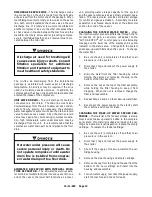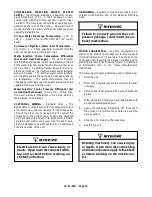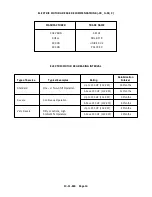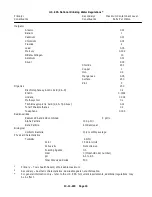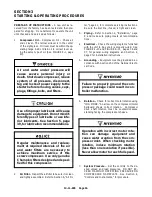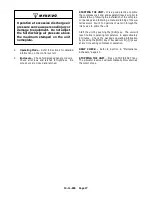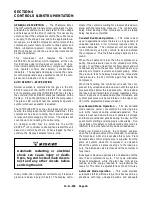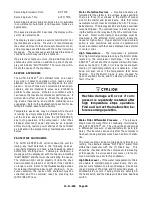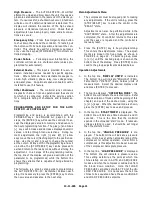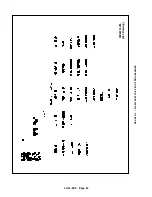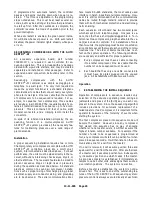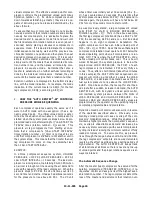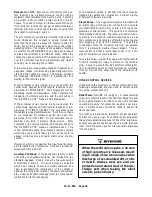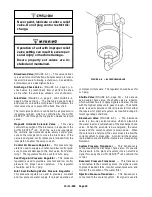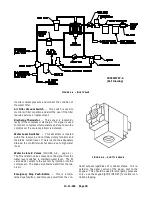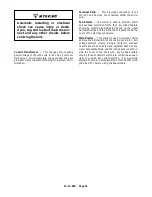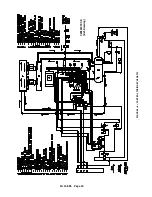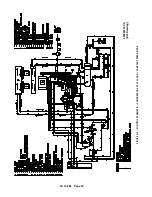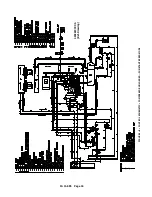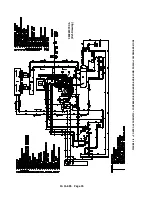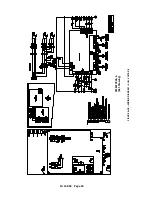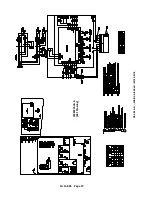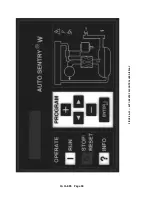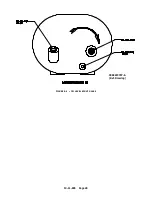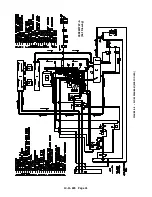
13- 11- 605
Page 26
vidual compressor. The effective unload point for com-
pressor control is the programmed unload point minus
3(rotation number -- 1). So while compressors count
down towards establishing a master, they are also ca-
pable of delivering air at a pressure determined by the
above formula.
To ensure that two or more machines do not simulta-
neously decrement their rotation numbers and simulta-
neously become masters, it is advisable to place the
desired master in sequence mode first and wait until
the first decrement in rotation number is seen (about 7
seconds) before placing subsequent compressors in
sequence mode. If it is desired to dictate the complete
initial sequence manually, wait until the previous ma-
chine decrements one position and then place the next
desired compressor in sequence mode. If it is accept-
able to let the master determine the initial sequence,
simply wait until the master has decremented its rota-
tion number once, and then place all remaining com-
pressors in sequence mode. Remember that once a
master is established, no further self-- decrementing is
done by the individual compressors. Instead, they will
wait until the master assigns them a rotation number.
Rotation numbers are displayed in the bottom display
line, with the mode indication. For example, the mode
indication for the current master is SEQ1; for the first
lag compressor, SEQ2; second lag, SEQ; etc.
2.
HOW THE “AUTO SENTRY
R
- W” CONTROLS
PRESSURE WHILE SEQUENCING
Each compressor operates exactly the same as if it
were in AUTO mode with one exception: it has a dy-
namic unload point. The initial unload point is deter-
mined by the equation shown above. A compressor is
started when the system pressure drops below its pro-
grammed load point, after waiting for [ ‘LAG START IN-
TERVAL’ times (rotation number -- 1)] seconds. This
prevents all lag compressors from starting at once.
Note that a compressor’s [‘LAG START INTERVAL’
times (rotation number -- 1)] timer is not reset to zero
until that compressor is started or until another unit in
the system stops. This means that the time for the next
lag compressor to come on may be somewhat less
than ‘LAG START INTERVAL’.
EXAMPLE:
In a three compressor sequence system, UNLOAD
PRESSURE = 100 PSI; LOAD PRESSURE = 90 PSI;
LAG START INTERVAL = 15 seconds. The lead com-
pressor is running alone, maintaining 90-- 100 PSI when
an air tool is brought on line causing the air demand to
exceed the capacity of the lead compressor. When the
pressure drops to 90 PSI, the #2 unit times out its 15
second timer and starts. It takes 5 additional seconds
for the pressure to rise above 90 PSI. The #3 unit
whose timer was initially set at 30 seconds (15 x [3 --
1]), has counted down 20 seconds (the total time that
system pressure was below 90 PSI). If air demand in-
creases again, the pressure will have to fall below 90
PSI for only 10 seconds more to start unit #3.
As was previously stated, a lag compressor’s unload
point (PSET for short) is [UNLOAD PRESSURE --
3(rotation number -- 1)]. Thus in the above example,
the first lag compressor (rotation #2) has a PSET of 97
PSI; the second lag, 94 PSI, and so on. But look what
happens in an eight compressor installation: The
eighth compressor will have an initial unload point of
[100 -- 3(8 -- 1)], or 79 PSI. Does this mean that an eight
compressor installation must operate 21 PSI below the
desired operating point when all compressors are run-
ning? NO! This is where the AUTO SENTRY
R
-- W dy-
namic unload point control takes over. This is how it
works: Whenever the system pressure is below the
programmed LOAD PRESSURE, the PSET of each
lag compressor is incremented 1 PSI every thirty se-
conds. Thus, after a short interval (about five minutes
in this example), the PSET of the last sequenced com-
pressor will climb up until either it equals the LOAD
PRESSURE, or a decrease in demand causes the ac-
tual system pressure to rise above the LOAD PRES-
SURE. It can be seen then, that except for short peri-
ods just after a sudden increase in demand, the AUTO
SENTRY
R
-- W, with its dynamic unload point control,
will maintain system pressure between the limits of
LOAD PRESSURE and UNLOAD PRESSURE. Re-
member, LOAD and UNLOAD PRESSURE values are
programmed by the operator so the operating range is
completely programmable and predictable.
Dynamic unload point control will also work in reverse
of the operation described above. Obviously, incre-
menting unload points will cause overlap of the com-
pressors’ modulation ranges. While this enables us to
maintain a higher pressure than competitor’s sequenc-
ers, overlap is undesirable as demand decreases, be-
cause a system could end up with several compressors
cycling instead of running the minimum number of fully
loaded compressors. To overcome this, as pressure
rises through the range between LOAD and UNLOAD,
the lag compressors’ setpoints are now decremented,
reversing the effect described above during periods of
high demand. The AUTO SENTRY
R
-- W keeps track
of all functions at all times so there is never any mix-- up
of unload points and the proper rotation sequence is al-
ways maintained.
The Automatic Sequence Change
After the master (lead) compressor has served for the
duration programmed (TRANSFER INTERVAL), it re-
linquishes control and assigns itself the highest avail-
able rotation number. The lag compressors detect the
loss of the master and decrement their rotation num-
Summary of Contents for ROTORCHAMP RCOF20
Page 13: ...13 11 605 Page 4 FIGURE 1 6 AIR WATER SCHEMATIC 300EWC797 B Ref Drawing ...
Page 16: ...13 11 605 Page 7 DECALS 206EAQ077 300EWC077 301EWC077 211EAQ077 207EAQ077 ...
Page 17: ...13 11 605 Page 8 DECALS 216EAQ077 206EWD077 222EAQ077 221EAQ077 208EAQ077 ...
Page 31: ...13 11 605 Page 22 FIGURE 4 2 FLOW CHART FOR SET UP PROGRAMMING 300EWC1255 Ref Drawing ...
Page 41: ...13 11 605 Page 32 FIGURE 4 6 CONTROL TUBING SCHEMATIC 300EWC797 B Ref Drawing ...
Page 45: ...13 11 605 Page 36 FIGURE 4 10 WIRING DIAGRAM FULL VOLTAGE 301EWC546 A Ref Drawing ...
Page 46: ...13 11 605 Page 37 FIGURE 4 11 WIRING DIAGRAM WYE DELTA 302EWC546 A Ref Drawing ...
Page 47: ...13 11 605 Page 38 FIGURE 4 12 AUTO SENTRY W CONTROLLER DISPLAY ...
Page 49: ...13 11 605 Page 40 FIGURE 5 1 OIL LEVEL SIGHT GLASS 306EWC797 A Ref Drawing ...
Page 50: ...13 11 605 Page 41 FIGURE 5 2 FLOW DIAGRAM AIR COOLED 300EWC797 A Ref Drawing ...

